Input interpretation

sulfuryl chloride
Chemical names and formulas
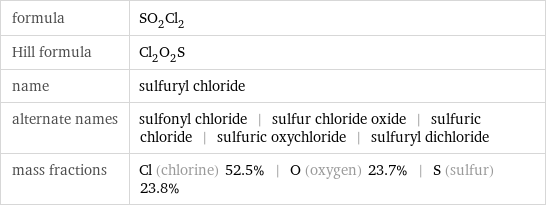
formula | SO_2Cl_2 Hill formula | Cl_2O_2S name | sulfuryl chloride alternate names | sulfonyl chloride | sulfur chloride oxide | sulfuric chloride | sulfuric oxychloride | sulfuryl dichloride mass fractions | Cl (chlorine) 52.5% | O (oxygen) 23.7% | S (sulfur) 23.8%
Lewis structure

Draw the Lewis structure of sulfuryl chloride. Start by drawing the overall structure of the molecule, ignoring potential double and triple bonds: Count the total valence electrons of the chlorine (n_Cl, val = 7), oxygen (n_O, val = 6), and sulfur (n_S, val = 6) atoms: 2 n_Cl, val + 2 n_O, val + n_S, val = 32 Calculate the number of electrons needed to completely fill the valence shells for chlorine (n_Cl, full = 8), oxygen (n_O, full = 8), and sulfur (n_S, full = 8): 2 n_Cl, full + 2 n_O, full + n_S, full = 40 Subtracting these two numbers shows that 40 - 32 = 8 bonding electrons are needed. Each bond has two electrons, so we expect that the above diagram has all the necessary bonds. However, to minimize formal charge oxygen wants 2 bonds. Identify the atoms that want additional bonds and the number of electrons remaining on each atom: In order to minimize their formal charge, atoms with large electronegativities can force atoms with smaller electronegativities on period 3 or higher to expand their valence shells. The electronegativities of the atoms are 2.58 (sulfur), 3.16 (chlorine), and 3.44 (oxygen). Because the electronegativity of sulfur is smaller than the electronegativity of oxygen, expand the valence shell of sulfur to 6 bonds. Therefore we add a total of 2 bonds to the diagram: Answer: | |
3D structure

3D structure
Basic properties
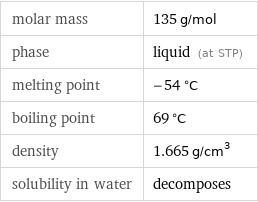
molar mass | 135 g/mol phase | liquid (at STP) melting point | -54 °C boiling point | 69 °C density | 1.665 g/cm^3 solubility in water | decomposes
Units

Liquid properties (at STP)
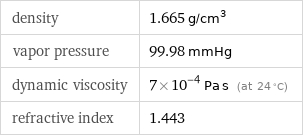
density | 1.665 g/cm^3 vapor pressure | 99.98 mmHg dynamic viscosity | 7×10^-4 Pa s (at 24 °C) refractive index | 1.443
Units

Thermodynamic properties
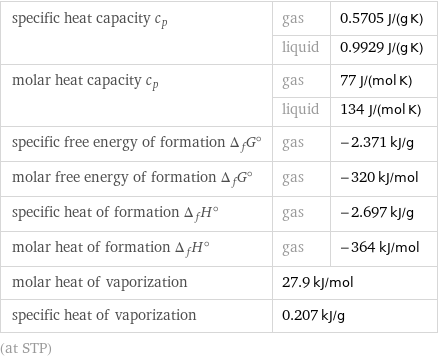
specific heat capacity c_p | gas | 0.5705 J/(g K) | liquid | 0.9929 J/(g K) molar heat capacity c_p | gas | 77 J/(mol K) | liquid | 134 J/(mol K) specific free energy of formation Δ_fG° | gas | -2.371 kJ/g molar free energy of formation Δ_fG° | gas | -320 kJ/mol specific heat of formation Δ_fH° | gas | -2.697 kJ/g molar heat of formation Δ_fH° | gas | -364 kJ/mol molar heat of vaporization | 27.9 kJ/mol | specific heat of vaporization | 0.207 kJ/g | (at STP)
Chemical identifiers

CAS number | 7791-25-5 PubChem CID number | 24648 PubChem SID number | 24849699 SMILES identifier | O=S(=O)(Cl)Cl InChI identifier | InChI=1/Cl2O2S/c1-5(2, 3)4 RTECS number | WT4870000 MDL number | MFCD00011451
NFPA label

NFPA label
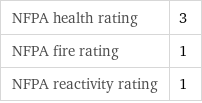
NFPA health rating | 3 NFPA fire rating | 1 NFPA reactivity rating | 1
Toxicity properties

RTECS classes | tumorigen